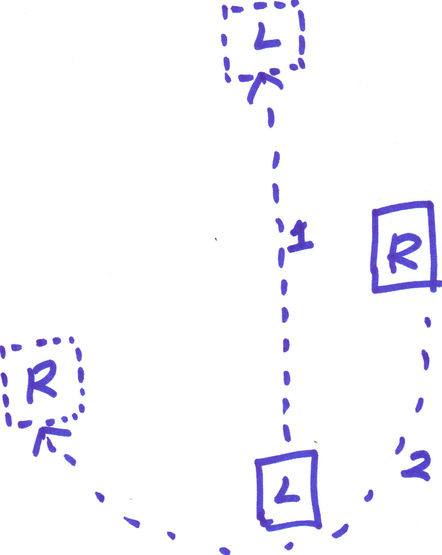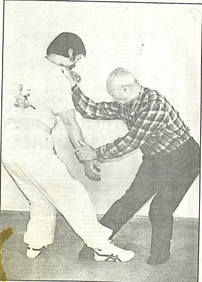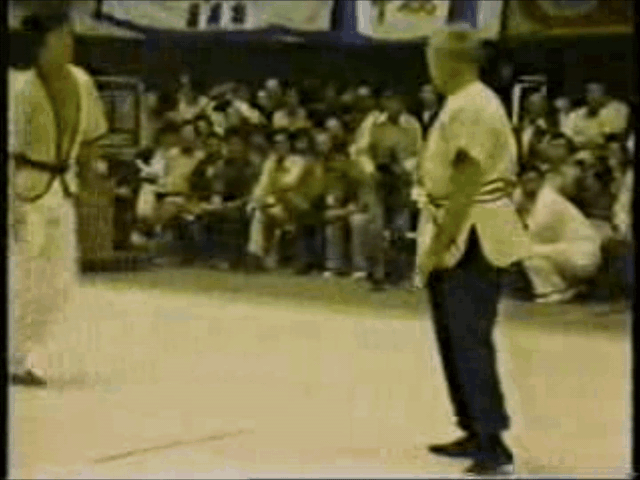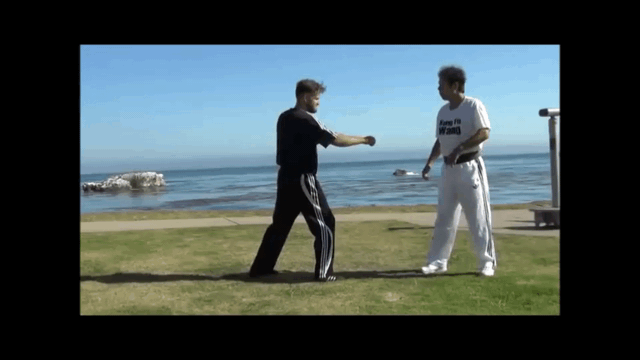Navigation
Install the app
How to install the app on iOS
Follow along with the video below to see how to install our site as a web app on your home screen.
Note: This feature may not be available in some browsers.
More options
Style variation
You are using an out of date browser. It may not display this or other websites correctly.
You should upgrade or use an alternative browser.
You should upgrade or use an alternative browser.
Bagua Circle Walking - Now it makes sense.
- Thread starter JowGaWolf
- Start date
Flying Crane
Sr. Grandmaster
Good find, this video. Good examples of proper use of bagua stepping.
This is exactly what I was getting at in a couple other threads where I said if a bagua guy just starts circle-walking around his enemy, while out of reach and failing to use that step to position for advantage while engaging the combat, then he is accomplishing nothing, is wasting his energy, and does not understand bagua.
A bagua guy who thinks, “oh I do bagua, I need to start walking around my enemy” does not understand bagua.
This is exactly what I was getting at in a couple other threads where I said if a bagua guy just starts circle-walking around his enemy, while out of reach and failing to use that step to position for advantage while engaging the combat, then he is accomplishing nothing, is wasting his energy, and does not understand bagua.
A bagua guy who thinks, “oh I do bagua, I need to start walking around my enemy” does not understand bagua.
Yep you nailed it. Right on target. When I watched this video, I thought to myself "Damn. all those people who actually train it got it wrong." Talk about the disconnect between practice and application.Good find, this video. Good examples of proper use of bagua stepping.
This is exactly what I was getting at in a couple other threads where I said if a bagua guy just starts circle-walking around his enemy, while out of reach and failing to use that step to position for advantage while engaging the combat, then he is accomplishing nothing, is wasting his energy, and does not understand bagua.
A bagua guy who thinks, “oh I do bagua, I need to start walking around my enemy” does not understand bagua.
After you posted your statement about it, I started to wonder why the circles are so small. I put an imaginary person at the center of the circle and clearly saw that it was too close to be used as I originally thought it may have been used on the outside. Video after video, all I saw were circles that were too small to be used to circle like people do in a ring. Bagua seems to be a close range fighting system and not a long one. So from the perspective of a close range fighting system, then the stepping makes more sense, the circle size makes more sense.
So many practitioners are getting it wrong at the root, which is why none of the other stuff is working for them. At a close range like that, I wouldn't have the opportunity to sweep someone like what was shown in Wangs video. I could get a few foot hooks, but definitely not a sweep. Looking at that video, I'm staring to imagine a fighter that smothers and not one that fights from the outside.
If you walk around your opponent fast enough, your opponent will turn into a new born baby.
In your clip, when she applies neck wiping, he is using "wheeling step" that has nothing to do with her Bagua walking. The wheeling step does not cross legs.

In your clip, when she applies neck wiping, he is using "wheeling step" that has nothing to do with her Bagua walking. The wheeling step does not cross legs.

Last edited:
do walk counter clockwise or clockwise?If you walk around your opponent fast enough, your opponent will turn into a new born baby.
The Bagua small circle is used to train shin bite and reverse shin bite.




Most (if not all) Bagua guys walk clockwise - to the left.do walk counter clockwise or clockwise?
My knowledge in Bagua is only at the 8 palms level.
oh I was referring to the movie clip. Do I walk fast counter clockwise or clockwise to turn someone into a baby? lolMost (if not all) Bagua guys walk clockwise - to the left.
My knowledge in Bagua is only at the 8 palms level.
Xue Sheng
All weight is underside
Now Bagua circle walking makes sense to me. Finally.
I have not done any serious baguazhang for a long time, but I had a couple of Baguazhang teachers that worked with applications and they were all in close. However many MANY bagua schools do not work applications these days....
My first bagua teacher would put you in the center and have the class surround you and attack
Back in the old days Bagua was allegedly very good at dealing with multiple attackers
skribs
Grandmaster
Good find, this video. Good examples of proper use of bagua stepping.
This is exactly what I was getting at in a couple other threads where I said if a bagua guy just starts circle-walking around his enemy, while out of reach and failing to use that step to position for advantage while engaging the combat, then he is accomplishing nothing, is wasting his energy, and does not understand bagua.
A bagua guy who thinks, “oh I do bagua, I need to start walking around my enemy” does not understand bagua.
We do a lot of similar footwork in Hapkido. I originally wanted to do Bagua before starting TKD, but there was no Bagua school in the area. My TKD school does HKD, and we do a bit of the footwork. Our primary focus is on the joint locks, but they don't work without the footwork.
With that said, my purpose was not to win a fight. My purpose was to get to a weapon. The 21-foot rule is that if someone is 21 feet away or less, and they charge you with a knife (or a sucker punch), you're not likely to get to your weapon in time to be able to defend the attack. Thus, my purpose for the circular footwork would be to maintain distance, and it wouldn't be a waste of energy. It would be to spare time while I am able to draw a firearm, or at least find an improvised weapon if I'm not carrying. At that point, hopefully the fight is over, and if not I have something much more effective than my fists to try and stop it.
Funnily enough, I don't carry anymore, because I can't carry at work, and I can't have anything on me except my uniform at the dojang. But that was my initial reason for learning martial arts, is to fix that vulnerability inside the 21-foot rule.
This is an application that wouldn't be applicable in the ring, but definitely would for self-defense.
Flying Crane
Sr. Grandmaster
From what I understand, bagua has a lot of joint manipulation material.We do a lot of similar footwork in Hapkido. I originally wanted to do Bagua before starting TKD, but there was no Bagua school in the area. My TKD school does HKD, and we do a bit of the footwork. Our primary focus is on the joint locks, but they don't work without the footwork.
With that said, my purpose was not to win a fight. My purpose was to get to a weapon. The 21-foot rule is that if someone is 21 feet away or less, and they charge you with a knife (or a sucker punch), you're not likely to get to your weapon in time to be able to defend the attack. Thus, my purpose for the circular footwork would be to maintain distance, and it wouldn't be a waste of energy. It would be to spare time while I am able to draw a firearm, or at least find an improvised weapon if I'm not carrying. At that point, hopefully the fight is over, and if not I have something much more effective than my fists to try and stop it.
Funnily enough, I don't carry anymore, because I can't carry at work, and I can't have anything on me except my uniform at the dojang. But that was my initial reason for learning martial arts, is to fix that vulnerability inside the 21-foot rule.
This is an application that wouldn't be applicable in the ring, but definitely would for self-defense.
which one do you want to see in the fight?Cool. Let's see them pull that off in a fight.
Hanzou
Grandmaster
which one do you want to see in the fight?
I want to see her get into a ring against a MMA woman who is trying to take her head off. I then want to see her attempt to perform what she did in that video without getting punched in the face over and over again.
This is not a realistic expectation. You wouldn't expect a fighter to not get punch in the face over and over. It's fighting, and you get get hit. Sometimes you get hit with a single strike other times you get hit with a combo Even you block it's still hitting you.what she did in that video without getting punched in the face over and over again.
If you can grab a person's wrist in a real fight, then the first part should be possible. Grapplers do it all the time. If you can slip your hand through to set up a clinch then the second part of the technique should be just as possible.
The third part is him trying to retreat to create distance and her chasing him while controlling the head. Control the head and you can control the body. The circling probably keeps the opponent from being able to resist in one direction. This is how the circular movements in long fist is done. When you punch straight you are unable to resist pressure to the side of your arm. When you decide to resist the side movement you are no longer sending your attack forward, and by the time you try to resist to the side pressure, I would have already been then be sending pressure down on the arm. This works because you would have been trying to resist from side pressure which is no longer there. You would always be behind.
In this type of scenario linear will never be able to beat circular. The only way to be able to counter this is to beat circular movement with circular movements. I speak of this from experience of having my head whipped around in a similar manner. The only difference was that the person didn't bother to use arm control. and he didn't chase me. It turned me 90 degree, I think I would have done a 180 had I put more forward movement into my attack.
I had my wife try this on me so I can feel first hand of what may be going on. And I think I'm correct about how the direction changes. I would resist until she started to walk behind me and then I would stumble. Every time I tried to lift my head direction of pressure on my neck would change and I would stumble forward. And now my neck hurts from resisting, not being able to resit at the right moment in the right direction. The direction of the pressure on my neck was always changing. Then I thought I could go for the legs for a take down but the faster I moved the faster she moved. I could resist when I was standing up straight but it's all over if I bend over. If someone with the same strength as me did it, then there's no way I could resist if it happened quickly. The structure just isn't there The only thing I can say is lift with your knees and not your back or your neck.
I don't train Bagua so I can't tell you beyond the bits and piece that I was able to pick out. I just know that there isn't anything about it that isn't impossible. The rest would depend on how the person reacts. to the technique. Like a lot of fighting techniques, if the person doesn't move the way you need them to move then the technique will fail. This is true in all fighting systems.
The better a person is at herding his opponent, the more likely the technique will be successful. We often see the failure in this ability with beginner's and people who only train form that think they can fight.
oh I was referring to the movie clip. Do I walk fast counter clockwise or clockwise to turn someone into a baby? lol
Counter clockwise obviously....sheesh.
Xue Sheng
All weight is underside
From what I understand, bagua has a lot of joint manipulation material.
yes, but different styles emphasize different things. Yin emphasizes striking, Cheng emphasizes Shuaijao, etc
Last edited:
Hanzou
Grandmaster
This is not a realistic expectation. You wouldn't expect a fighter to not get punch in the face over and over. It's fighting, and you get get hit. Sometimes you get hit with a single strike other times you get hit with a combo Even you block it's still hitting you.
Sure, but I'm talking about getting punched in the face over and over again without doing anything to really stop it. In short, while that certainly looks nice, it doesn't look very realistic or practical.
If you can grab a person's wrist in a real fight, then the first part should be possible. Grapplers do it all the time. If you can slip your hand through to set up a clinch then the second part of the technique should be just as possible.
There's a big difference between grabbing a wrist in mid punch and grabbing a wrist in a clench. BTW, grabbing a wrist in a clench isn't very easy either.
The third part is him trying to retreat to create distance and her chasing him while controlling the head. Control the head and you can control the body. The circling probably keeps the opponent from being able to resist in one direction. This is how the circular movements in long fist is done. When you punch straight you are unable to resist pressure to the side of your arm. When you decide to resist the side movement you are no longer sending your attack forward, and by the time you try to resist to the side pressure, I would have already been then be sending pressure down on the arm. This works because you would have been trying to resist from side pressure which is no longer there. You would always be behind.
In this type of scenario linear will never be able to beat circular. The only way to be able to counter this is to beat circular movement with circular movements. I speak of this from experience of having my head whipped around in a similar manner. The only difference was that the person didn't bother to use arm control. and he didn't chase me. It turned me 90 degree, I think I would have done a 180 had I put more forward movement into my attack.
This is all theory, and while I appreciate it, I'm simply asking to see this theory being applied. Again, the demonstrations are nice, but that's really all they are. I would like to see this stuff being done against a resisting opponent. I don't think that's too much to ask.
I swear to God that the following event did happen as I have described here several years ago.There's a big difference between grabbing a wrist in mid punch and grabbing a wrist in a clench. BTW, grabbing a wrist in a clench isn't very easy either.
I talk to a CMA instructor to express my concern about the WC Bong Shou that expose elbow (in CMA, one should never expose his elbow to his opponent). The WC instructor disagreed. He asked me to punch him.
- I right punched to his face.
- He blocked with a right Bong Shou (wrong Bong).
- I slid my right arm down along his right blocking arm. I then use my left hand to push his right elbow up.
- He dropped his right elbow down (resist my upward elbow push), and punched me with his left hand.
- I used left hand to take over my right grip on his right wrist (free my right hand). I then used my right hand to grab his left wrist when his left punch is coming toward my face.
- I pinned his left arm against his own right arm and also against his own body.
- He could not break my both grips. I let go. He said I had strong grips.
The reason that I could control his
- right wrist because I punch first and he blocks. It's easier to grab a blocking arm than to grab a punching arm.
- left wrist because after I had controlled his right wrist, I could sense his left arm intention. My right hand move the same direction as his left punch (just like a hook punch). This gave me plenty of time to grab his left wrist.
The person who I dealt with was a quite famous WC instructor (about my age). Since he needed to protect his personal reputation, I don't think he would let me do what I want to do without "full resistance".
The process is exactly the same as the following clip except my opponent was a full resisted stranger and CMA expert.

Last edited:
Similar threads
- Replies
- 4
- Views
- 2K
- Replies
- 14
- Views
- 9K
- Replies
- 2
- Views
- 2K
